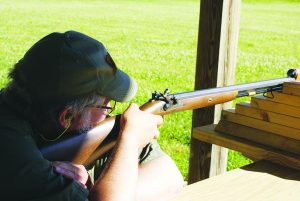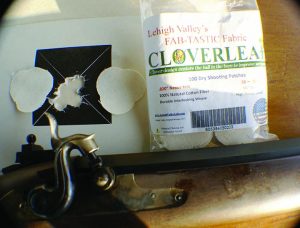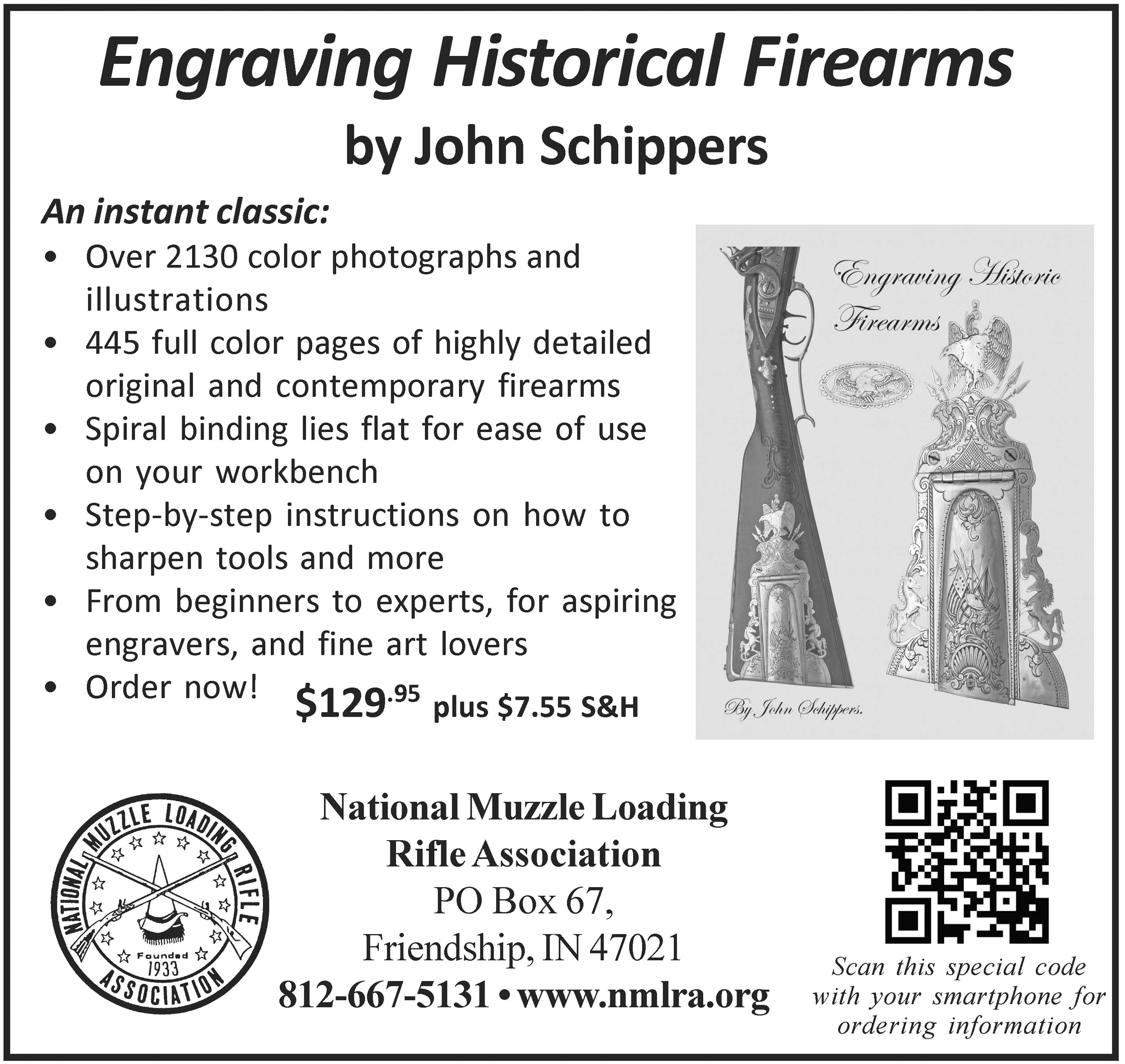by Jim Fulmer | Past President, NMLRA

At 30 yard table shoot range; notice shaders added.
When I was asked to do a review of one of Davide Pedersoli’s latest firearms, I jumped at the opportunity. The firearm company Davide Pedersoli started building modern double-barrel and over-under shotguns in 1958. It was in 1960 that the company began to build muzzleloaders. The company is currently managed by the son, Pierangelo Pedersoli, and brother-in-law, Giovanni Gottardi.
Pierangelo loves traditional style muzzleloaders and firearms. It can be seen in the quality of the reproductions the company produces. This company is the largest manufacturer of muzzleloading rifles in the world. Traditional style muzzleloaders have dropped in popularity for hunting in the United States. Many muzzleloading hunters have never even shot a traditional style muzzleloader because they where introduced to hunting through the modern inline-style muzzleloading rifles.
Many of these new modern style muzzleloaders have rates of twist of 1 turn in 36 inches – a faster rotation in the rifling. The spin on the ball or bullet is what gives rifles the accuracy they have over a barrel with no rifling. This fast twist makes these inline firearms shoot their lead or saboted copper-jacketed bullets with a very fast spin. They fly like footballs and use the faster twist or rotation in the barrel to better stabilize their flight. Slow velocity does not work well when you are hunting. By increasing the speed of rotation, a muzzleloader can use a modern day style bullet. Hunters enjoy accuracy and game taking performance at 100 to 200 yards with the proper loads.
Traditional style patched round-ball muzzleloaders are best used at 50 to 125 yards on big game. Traditional style muzzleloaders have barrels that are commonly rifled one turn in 48” all the way up to one turn in 72”. Basically saboted bullets don’t like a slow twist and patched round balls don’t a like fast twist.
The creative minds at the Pedersoli Company have started putting the faster bullet-style twist barrels in their traditional style firearms. By changing the twist of the rifling in an older looking style rifle to a bullet twist of the new style in-lines, the Pedersoli Company has achieved the best of both worlds. They have done this in several rifles, and now they have done it again with the percussion “Traditional Hawken Hunter Rifle.”
Pedersoli advertising states that their Traditional Hawken Hunter rifle is a “19th Century Style for the 21st Century Hunter.” At first glance the Pedersoli Hawken looks like a standard traditional rifle. When you look at it closer, you will notice a ghost ring aperture sight mounted on the tang. The ghost ring sight enables you to quickly get on your target for sight alignment and has been used on modern hunting and military rifles for years. The ghost ring on the test rifle measured .150 thousands with a .050 brass bead style front sight. The rifle is shot by instinct with your eye centering the front sight and target in the center of the ghost ring.

Note 10 shots fired at 30 yards using Leigh Valley patch lubricant and the “Cloverleaf patch.”
The ghost ring sight is fully adjustable for windage and elevation. The adjustments are made by loosening slotted screws and sliding the sight in a dovetail for windage and screwing the threaded aperture up and down for elevation then retightening the screw. I notice the rear sight when moved any distance for elevation you would have to change the windage. Once a hunting load is found there is no reason to move the sights.
The stock is made with American walnut which has a rubber style, micro cell butt plate to absorb recoil. I almost took the recoil pad off after my first ten shots with this rifle. Why? I was at the National Muzzle Loading Rifle Association Spring Nationals at Friendship, Indiana, and shooting in what is called a “table shoot” with my .40 caliber open iron flint longrifle. When I was done competing I got the Hawken Hunter out and started shooting at a practice target just to get the rifle dirty and learn the feel of the trigger. This rifle has a six groove .50 caliber barrel with a one turn in 24” twist. It is made for shooting bullets.
One time I shot for Dixie Gun Works on their manufacturer’s team with a .54 caliber American Flintlock Jaeger made by Pedersoli that was also a one turn in 24”. It was a four man team and we shared our findings with each other about what made these guns shoot. We all discovered the one in 24” twist in that .54 caliber Jaeger would handle a patched round-ball if you kept your powder charge under 60 grains of FFFg of black powder. Many team members shot this load at the 50 yard target of this match and didn’t use the saboted bullet until 100 yards and beyond.
The table shoot is shot at 30 yards at the NMLRA Spring Nationals so I thought being that it was a .50 caliber with the same twist as the .54 caliber Jaeger, I would try 50 gr. of FFFg black powder. I hung a practice target up and decided to start shooting the rifle. Having just purchased some Leigh Valley Lube and some of their new Cloverleaf patching material, I decided I would try everything at once. Using a .495 diameter round ball with a .020 Cloverleaf Patch pushed by 50 gr. of FFFg back powder, I started to shoot. I fired three five-shot strings sighting in to get center on my first target. I saw right away it was going to shoot fine. I fired ten more shots and you couldn’t tell where several of the shots went — they went through one ragged hole at 30 yards.
I would like to have entered the rifle in the table match at the Nationals, but the rules for the match stated: “No false muzzles or rubber recoil pads.” There is a match for the ghost ring sight, but not for the recoil pad. As sweet as the gun shot, I could almost justify putting a brass butt plate on it just for that match!
Later in July at the NMLRA Pennsylvania Territorial Championship, I won an individual gold medal using the same load by shooting a score of 48 1-X in the Unlimited Longhunter’s Offhand Squirrel Target.
But this rifle was not made for shooting patched round-ball. It was made for shooting bullets at longer ranges with more knock down power. Searching for the right load for a sabot and bullet combination can get a bit expensive if you want to experiment. I recommend finding a friend or going to a muzzleloading club to see if you can borrow some sabots and bullets to try from fellow shooters. As a shooter, you will know in about three shots if your combo is right or not.
I loaded the Hawken Hunter with my favorite load, the Harvester Crushed Rib Sabot and a 300 gr. Hornady XTP Mag bullet, that I use for hunting. I usually use 100 gr. FFFg black powder for hunting, but I started with 80 gr. and worked my way up shooting five shot groups and then adding another 5 gr. of powder. The groups kept getting smaller as I increased the powder charge. The barrel on this Hawken is 28-3/8” long, and with 110 gr. of FFFg it actually did shoot its best group at 100 yards with the ghost ring sights and the 300 gr. bullet. The group was just less than four inches centered. I feel the rifle is capable of under 2 inch groups with a scope.
The .50 caliber round ball weighs 180 gr. and with 100 gr. of FFFg black powder it has about 800 foot pounds of energy at 50 yards. A .50 caliber 300 gr. bullet with 100 gr. FFFg has about 1,500 foot pounds of energy at 50 yards. But you go to 100 yards the 180 gr. round ball only has about 450 foot pounds left verses the 300 gr. bullet with about 1,250 foot pounds of energy. There is a big advantage with a bullet when shooting big game size animals over 50 yards.
Pederosli’s Traditional Hawken Hunter Rifle is made for the hunter. With double set triggers and the front sling swivel fitted to the lower rib and a slotted stud in the stock ready for a sling to take it to the woods. It is everything you would ever need and want in a traditional muzzleloading hunting rifle.




